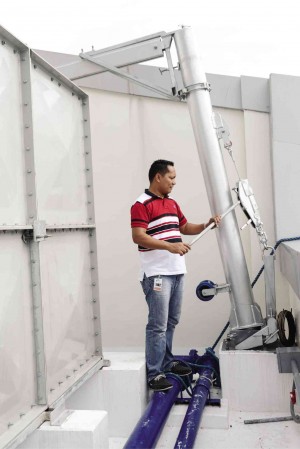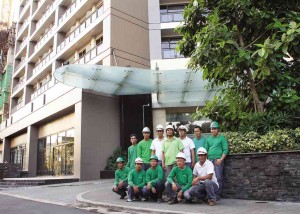Gondola lifts find a niche in the high-rise market
Three years ago, the news of ten construction workers who plummeted to their deaths in a high-rise construction, shook the real estate industry. While installing glass, the workers fell from the 32th floor to the seventh floor of a high-end, 39-story residential development in Makati. They were descending on a manual gondola lift when the cable snapped. According to some reports, the accident was caused by overloading. The capacity of the gondola was limited to six persons, but 11 workers rode on them. One survived the accident, but was severely injured.
The accident raised safety issues in the construction industry. Consequently, the Makati City Hall issued an ordinance that buildings over six floors were required to use motorized gondolas in construction and maintenance. Likewise, the laborers were required to use personal protective equipment (PPE) such as safety belt, helmet, lifeline and proper shoes. A safety officer would check if the workers were using their PPE’s on site.
The ordinance drove more businesses to Vonotec, supplier of gondola systems and provider of building maintenance services. Still, why wait for a tragedy before investing in quality equipment, says Henri Muzzarelli, Vonotec’s chief executive officer.
With the construction boom, Vonotec’s business has been doubling through the years. In 2013, it posted eight-digit gross sales.
One stop-shop

THE WORKER is secure in a gondola with advance technology and personal protection equipment. Photo by Nelson Matawaran
Vonotec popularized motorized gondolas as permanent installations in the building. Gondolas are suspended cradles designed for construction work and cleaning the façades of high rises. Unlike manual gondolas, motorized gondolas have more than the double safety features.
“As a building maintenance unit, the motorized gondola gives you safety access to any part of the skin of building. Why do you need to clean? The pollution from car exhaust consists of carbon dioxide. This sticks to the windows. When it rains, the water becomes acidic and affects the sealant. If you don’t clean buildings regularly, you will get leaks,” explains Muzzarelli. He recommends thorough maintenance before the rainy season.
“We are a one-stop-shop for the skin of the building,” says Muzzarelli. The company provides everything from façade repair, crack injections, resealing, leak cladding, repainting and waterproofing. During typhoon season, the office is flooded with phone calls from clients asking Vonotec to fix the leaks in their condos and offices.
With the surge of high-rises, developers have been integrating the gondolas into the architecture. That way, early planning avoids an unattractive addition to the building and also prevents unforeseen difficulties during construction.
“The weight of the gondola has to be taken into consideration in the design of the building. You have a more efficient building and a less expensive gondola if it is customized,” explains Muzzarelli.
He compares gondolas to vehicles. A small dismantable gondola which costs P5 million, is like riding on a tricycle. At P10 million, the rail-mounted gondola is equivalent to that of the motorcycle. The permanent gondola, which is as durable as an automobile, costs P30 to P50 million, depending on the building height. Some towers require at least three systems.
A-list clients
Muzzarelli says building maintenance takes three months to accomplish. The services can reach P500,000 to P1.5 million.
Muzzarelli maintains that Vonotec uses one of the safest gondolas in the industry. Built by the German company, FBA Gomyl GmBH, the equipment conforms to the safety requirements set by European (EN108) and American (ANSI) standards. He says in case one support system breaks, the gondola is equipped with back-ups or in industry terms, double redundancy.
After the workers get a certification for their training, they are sent to Tagaytay to become licensed mountaineering, learning how to rappel, climb towers, rescue at heights with PPEs.
Because of the company’s uncompromising standards, it has attractive blue-chip clients—Union Bank, Ascott Makati, Century Properties. Makati City Hall, Ospital ng Makati, Rockwell Land, Discovery Primea, Nuvo Land, Robinsons Land, SM’s E-Com, Resort World, Shangri-la Fort, and Twin Oaks, to name a few.

STANDING in front of Gramercy, one of Vonotec’s clients, the workers are certified for both building maintenance and mountaineering. Photo by Nelson Matawaran
Negotiator
The Franco-Italian businessman came to the Philippines in 1991 for an on-the-job training for Degremont, a water treatment plant. Then 24 years old, Muzzarelli met Rebecca “Becky” Garcia, president of well-known public relations firm, Chase Thomas and dancesport proponent. Smitten by the Filipina, Muzzarelli decided to stay in the Philippines after his six-month training.
To keep him busy, Garcia gave him jobs such as co-producing special events. She discovered that Muzzarelli’s business skills were sharp. He was intuitive and a good negotiator.
Upon a referral from a business contact, Muzzarelli acquired the distribution of Taprogge, a brand of an automatic condenser cleaning system for industrial air conditioning, made by the German company, Tractel.
In 1994, Garcia and Muzzarelli formalized the company for their business. They wanted to call it Novotec, derived from “nouveau” or new and technology. Since a company was already listed with that name, they switched it to Vonotec. It started with a lean staff, Garcia as the president; Muzzarelli, the managing director; a secretary and an engineer.
The first client, Ayala Property Management Corporation (APMC), purchased the condenser for the then Quad 1. Impressed with the performance, APMC then ordered condensers for 6750 Ayala and its other malls. Greenhills Shopping Center, Philips Semiconductors, Transcom Center, Trane Philippines and Tektite Tower followed.
Asian crisis
Meanwhile, the city skyline was changing. The new buildings featured glass curtain walls while the older ones were in need of maintenance. The real estate and construction boom spurred niche markets, including advance building technology. Vonotec ventured into motorized gondolas with Megaworld’s World Trade Center as the first client.
Then came the high-rises such as Philam Tower, Petron, Union Bank and Discovery Suites. Vonotec was booming in the mid’90s until the Asian Crisis in 1997.
Muzzarelli recalls that they were selling the equipment in pesos but were buying them in euros. The challenge was to make the business profitable and not to lose money due to the fluctuating exchange rate. Back then, the exchange rate jumped from P25 to $1 to P50 to $1, thus doubling up the costs of the machinery.
“Our margins weren’t high on the equipment. So all the money we made from 1996 to 1997 were used to pay the letters of credit and loans. I knew that by paying everything, we would survive. By 1998, we were the only ones in the market then,” says Muzzarelli.
However, at the start of the Zeros, new companies offering local motorized gondolas brought competition. Some claimed that their gondolas were imported but were actually made in China.
“Customers said, ‘Why pay so much for the equipment when I can get a cheaper price?’ The local machines don’t follow the international norms. You need double redundancy. If the motor breaks and the gondola starts to fall, there is a secondary brake that will prevent it. But the chances of two systems failing is low,” he says.
After the news of the gondola tragedy and the ensuing legal problems, developers looked into investing efficient motorized gondolas.
Aiming high
Twenty years in the business, Vonotec has grown from a staff of four to 60. Although Garcia is now happily married to a Greek-German businessman, they still work closely together. Garcia brings in the business and takes care of the clients.
“She’s my secret weapon,” says Muzzarelli.
He describes his management as “hands-on.” Says the 47-year-old executive, “We choose good principals and good products. With our checks and balances, we don’t use the company like an ATM.”
As the organization expands, he is aiming for an ISO 9001 certification, an international standard for quality management. The executive wants to give Vonotec a more competitive edge. He is setting formal guidelines to improve the operations, enhance regulatory requirements and improve performance.
With an ISO implementation, everybody in the company from the employees to the workers can appreciate quality and the importance of a good management system.
“So when client deals with us, we can ensure quality as per manuals,” says Muzzarelli.
